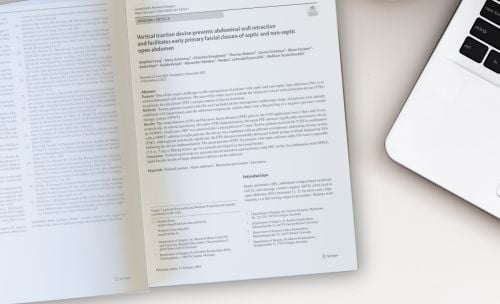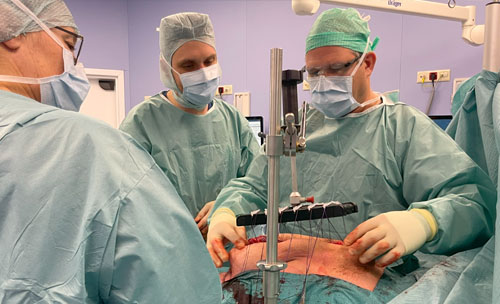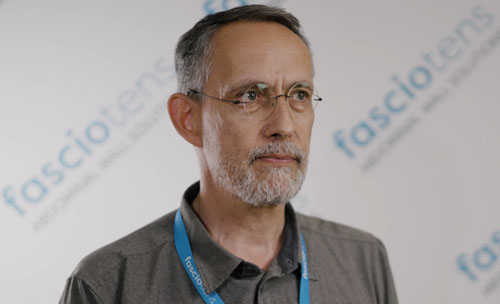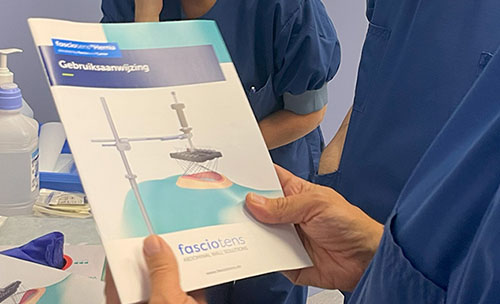fasciotens®Hernia Lengthening of the intact abdominal wall on demand
The most common approach to close complex ventral hernias without bridging includes extensive reconstructive procedures (e.g. component separation). These can come with an increased rate of complications and weaken the lateral abdominal wall.
Learn how applying intraoperative fascial traction facilitates the repair of complex hernias in a more gentle way and leads to higher rates of midline restoration*.
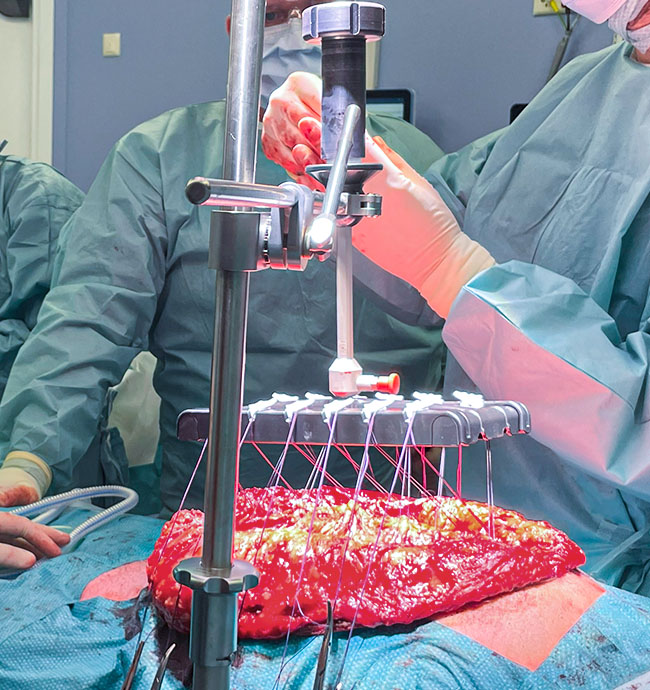
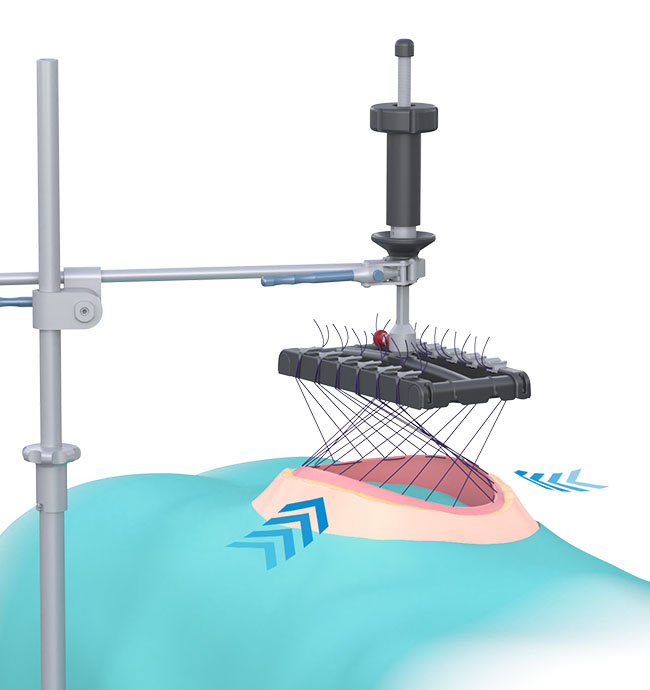
Gentle repair of complex hernias
Why is the fasciotens® solution spreading so fast?
Utilise myofascial elongation
Applying diagonal traction to the lateral abdominal wall leads to myofascial stretching. By following this procedure during surgery, it's possible to achieve direct fascial closure.
Avoid traumatic procedures
To achieve a midline closure in complex hernia repair, invasive techniques such as transverse abdominis release are often needed. These challenging techniques deliberately weaken the lateral abdominal wall and should be reserved for the most severe cases. We are convinced that a simpler and gentler approach for most cases should be pursued.
Quantifiable standardized traction
The fasciotens® system is well-probed, CE-certified and was confirmed in several clinical studies. Quantifiable and reproducible traction is applied on the abdominal wall, made visible by the integrated scale to adapt to different patient anatomy.
Another tool in the toolbox
fasciotens® shows impressive results from complex hernias with defects >8 cm width and loss of domain. However, in more challenging cases, the technique can easily be combined with other procedures. Surgeons regularly use fasciotens® together with Botox pre-treatment, TAR or others, depending on the case's requirements. Good to know: You can even use the device in a laparoscopic and robotic approach.
Register for our e-learning to get all the training material for the Hernia device
How does it work?
Intraoperative fascial traction allows myofascial elongation
The fasciotens®Hernia device applies vertical-diagonal traction to the abdominal wall intraoperatively. Usually, it takes approx. 30 minutes of traction.
Watch the 30-second video to get more insight
Support
Learn more about fasciotens®Hernia
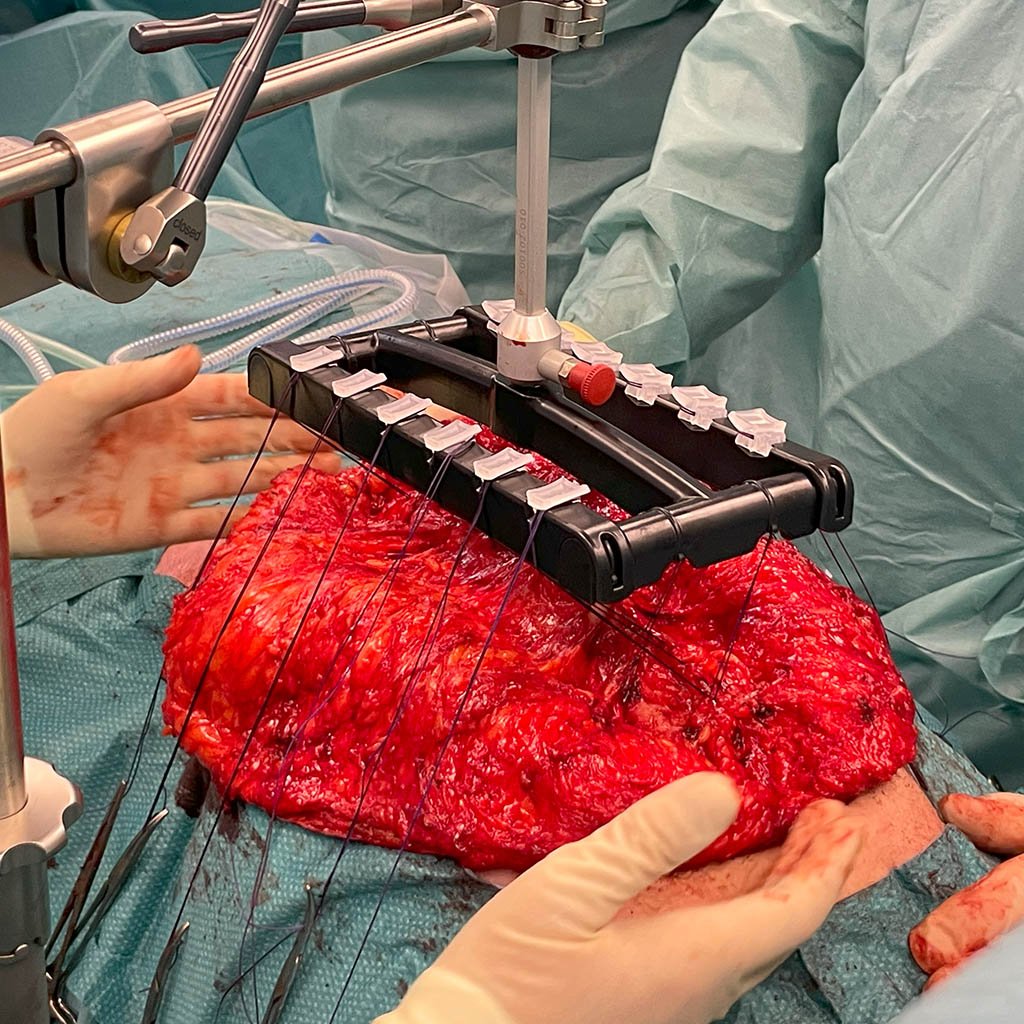
Case Report
Successful closure of a huge complex ventral hernia
This complex case showed massive adhesions due to previous surgeries. It was the surgeon's first application of fasciotens® leading to an optimal result for the patient.
- 25 cm defect in width
- Pre-treatment with Botox
- Rives-Stoppa repair
- Complete fascial closure after only 25 minutes
- No additional technique required
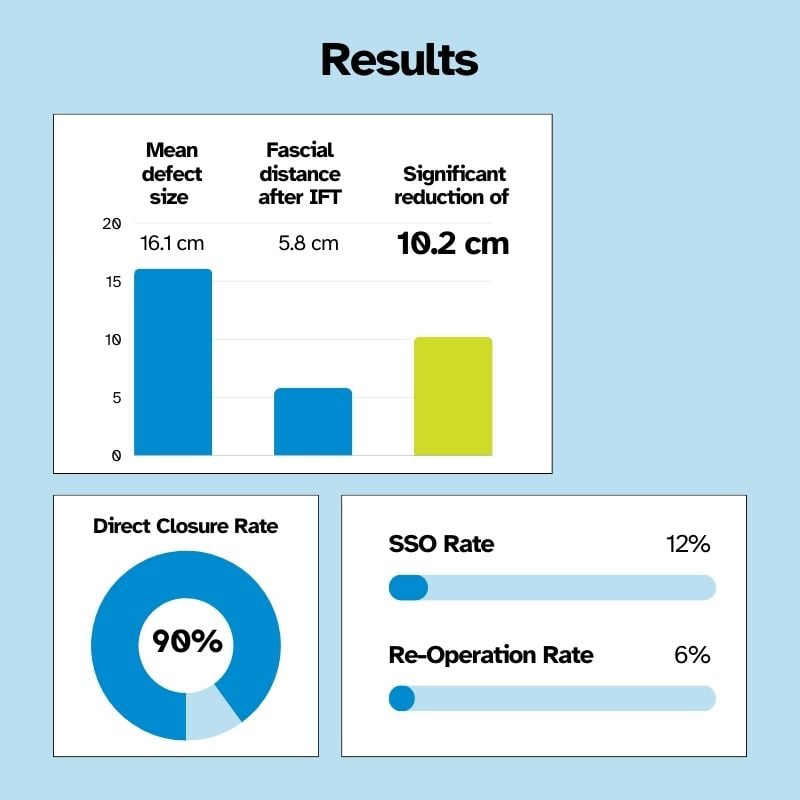
Publications
Intraoperative fascial traction (IFT) for the treatment of large ventral hernias
Chirurg 93, 292–298 (2022)
This retrospective analysis was carried out after treating 50 patients with fasciotens®Hernia in 11 different hospitals specialised in hernia surgery. The mean defect width was 16.1 cm
- No device-related events reported
- Sublay mesh augmentation in all cases
- direct closure rate of 90%
- low SSO rate of 12%
Frequently Asked Questions
Why should I add another technique to my repertoire?
fasciotens®Hernia is a powerful tool in your toolbox. While traditional methods can close most of the hernias, they come with a list of side effects and trade-offs. Recently, wide discussions arose about whether less invasive treatments should be utilised more regularly. fasciotens® allows a high rate of direct fascial closure.
Can I combine the fasciotens®Hernia therapy with other techniques?
Absolutely! Depending on the patient's condition and medical history, different techniques can or should be added to our approach. In many cases, a pre-treatment with Botox proved to be a successful combination. fasciotens® can also be used in laparoscopic and robotic procedures.
What's the procedure for my first application?
Just reach out to your local fasciotens partner or directly to us. One of our surgeons or fasciotens® specialists will discuss your case with you and together we agree on whether fasciotens is suitable. We will make sure that you will have a fasciotens® expert at your side during the treatment.
How long does the treatment with fasciotens®Hernia take?
That depends largely on your patient's condition. The device will be applied exclusively in the OR. After preparation (e.g. retrorectus dissection) the device is set up and fascial traction is normally carried out for approx. 30 minutes. In most cases the fascial edges can be closed directly afterwards.
What do I have to tell my anaesthesiologist?
Since you will apply traction among others to the muscles of the abdominal wall, the patient should be under full muscle relaxation during the whole procedure. Besides that, your in-house standards can be applied.
More than 1.000 successful applications
Surgeons' opinions on fasciotens®Hernia
"Applying fascial traction using fasciotens® is a simple procedure for treating large or loss of domain hernias and helps in some cases to avoid complicated component separations which might lead to a higher complication rate."

Prof. Henning Niebuhr
Head of Surgery, Hernia Center, Hamburg
"The promised gain in length was easily achieved intraoperatively in a loss-of-domain hernia (W3). Furthermore, component separation wasn't needed in this patient. This technique spares us with a costly and complication-prone procedure that also weakens the abdominal wall. It's a high benefit for the patient, especially in cases of increased co-morbidities."

Dr. Michael Rössler
Chief Surgeon, Rüdesheim
"With fasciotens, I was able to close a 16 cm wide hernia without the need for component separation. The patient complained of hardly any pain postoperatively and was discharged after 7 days. This is an impressive result for such a large hernia.
In particular, the risk of postoperative wound complications is significantly lower due to the much smaller wound area compared to the transversus abdominis release. After experiencing it, I am convinced of the effectiveness and benefits of fasciotens® in the treatment of complex abdominal wall hernias."

Prof. Guido Woeste
Head of surgery, Darmstadt
Hear what our users say:
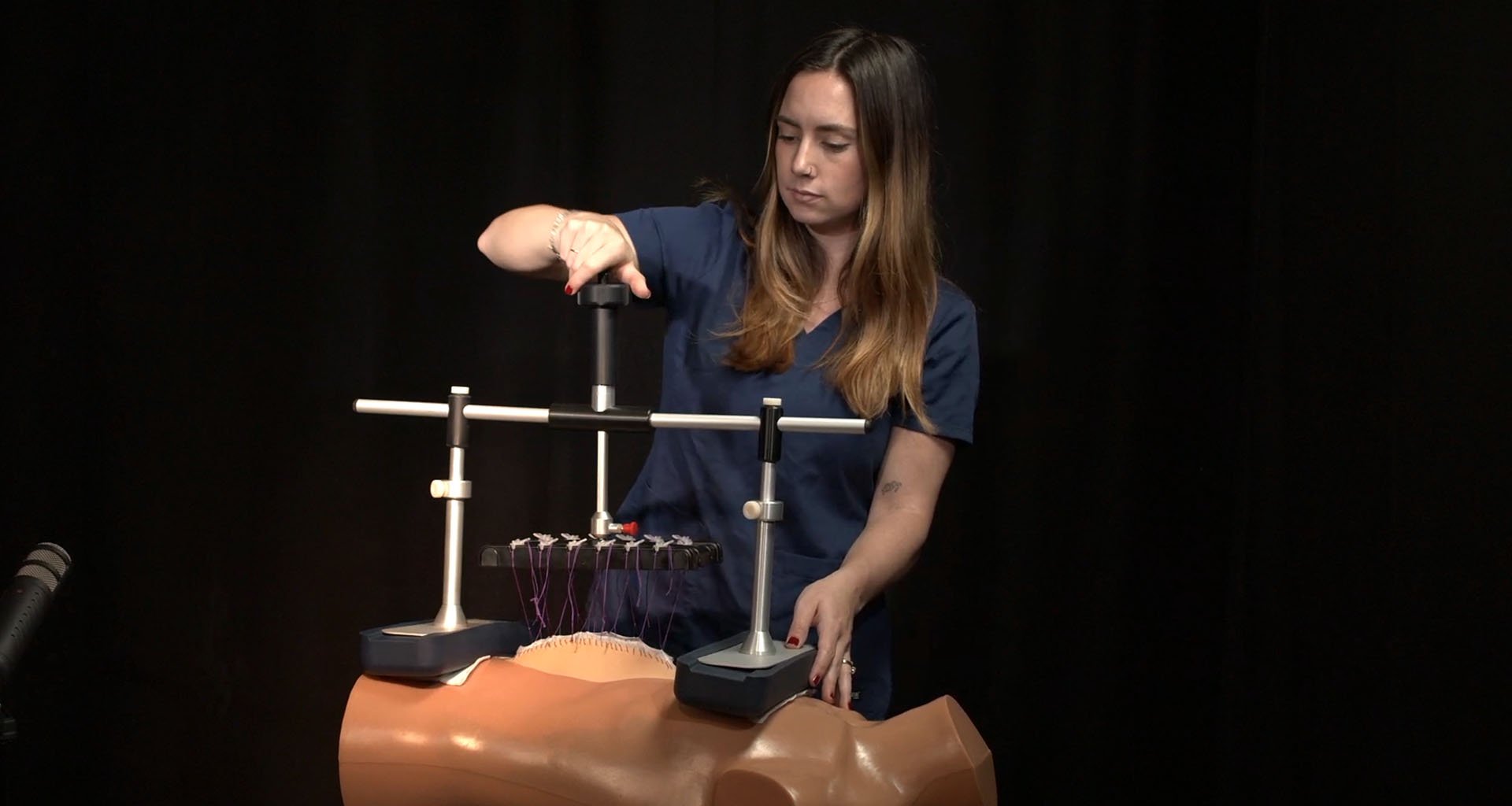
Watch the e-learning course about fasciotens®Hernia
Join this course for a thorough introduction to applying the fasciotens®Hernia device during surgery. The course includes a 3-minute set-up tutorial which you and your team can easily re-watch before each application.
*Sources & references
- Niebuhr, H., Malaibari, Z.O., Köckerling, F. et al. Intraoperative Faszientraktion (IFT) zur Behandlung großer ventraler Hernien. Chirurg 93, 292–298 (2022). https://doi.org/10.1007/s00104-021-01552-0
- Niebuhr H, Aufenberg T, Dag H, Reinpold W, Peiper C, Schardey HM, Renter MA, Aly M, Eucker D, Köckerling F and Eichelter J (2021) Intraoperative Fascia Tension as an Alternative to Component Separation. A Prospective Observational Study. Front. Surg. 7:616669. doi: 10.3389/fsurg.2020.616669
- Bloemendaal ALA (2022) Case Report: Intraoperative Fascial Traction in Robotic Abdominal Wall Surgery; An Early Experience. J. of Abdom. Wall Surg. 1:10356. doi: 10.3389/jaws.2022.10356
- Benoît Romain, Guillaume Sauvinet, Thomas Rebiere, A complex incisional hernia repair with Intraoperative Fascial Traction device (with video), Surgery Open Digestive Advance, Volume 8, 2022, 100062, ISSN 2667-0089, https://doi.org/10.1016/j.soda.2022.100062. (https://www.sciencedirect.com/science/article/pii/S2667008922000246)

